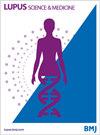Clinical significance of exostosin 1 in confirmed and suspected lupus membranous nephropathy
IF 3.7
2区 医学
Q1 RHEUMATOLOGY
引用次数: 0
Abstract
Objective This study aimed to investigate the clinical significance of exostosin 1 (EXT1) in confirmed and suspected lupus membranous nephropathy (LMN). Methods EXT1 was detected in 67 renal tissues of M-type phospholipase A2 receptor (PLA2R)-negative and ANA-positive membranous nephropathy by immunohistochemistry, and cases were divided into confirmed LMN and suspected LMN. The clinicopathological data were compared among the above groups, as well as EXT1-positive group and EXT1-negative group. Results Twenty-two cases (73.3%) of confirmed LMN and six cases (16.2%) of suspected LMN exhibited EXT1 expression on the glomerular basement membrane and/or mesangium area, showing a significant difference (p<0.001). Concurrently, lupus nephritis (LN) of pure class V demonstrated a lower frequency of EXT1 positivity compared with mixed class V LN in the confirmed LMN group (31.8% vs 68.2%, p=0.007). EXT1-positive patients in the confirmed and suspected LMN group showed significant differences in some clinicopathological data comparing with EXT1-negative patients (p<0.05). Follow-up data revealed that a greater proportion of patients in the EXT1-positive group achieved complete remission post-treatment (p<0.05). Cox regression analysis showed that EXT1 positivity was significantly correlated with complete remission across the entire study cohort (HR 5.647; 95% CI, 1.323 to 12.048; p=0.019). Kaplan-Meier analysis indicated that the EXT1-positive group had a higher rate of accumulated nephrotic remission compared with the EXT1-negative group in the whole study cohort (p=0.028). Conclusions The EXT1-positive group exhibited a higher active index and a more favourable renal outcome than the EXT1-negative group. It would be better to recognise suspected LMN with EXT1 positivity as a potential autoimmune disease and maintain close follow-up due to its similarities with confirmed LMN. Data are available upon reasonable request.外司素 1 在确诊和疑似狼疮膜性肾病中的临床意义
目的 本研究旨在探讨EXT1在确诊和疑似狼疮膜性肾病(LMN)中的临床意义。方法 采用免疫组化方法在 67 例 M 型磷脂酶 A2 受体(PLA2R)阴性和 ANA 阳性膜性肾病患者的肾组织中检测 EXT1,并将病例分为确诊 LMN 和疑似 LMN。比较上述各组以及 EXT1 阳性组和 EXT1 阴性组的临床病理数据。结果 22 例确诊 LMN(73.3%)和 6 例疑似 LMN(16.2%)的肾小球基底膜和/或系膜区有 EXT1 表达,差异显著(P<0.001)。同时,在确诊的 LMN 组中,纯 V 类狼疮肾炎(LN)的 EXT1 阳性率低于混合 V 类 LN(31.8% 对 68.2%,P=0.007)。确诊组和疑似 LMN 组的 EXT1 阳性患者与 EXT1 阴性患者相比,在一些临床病理数据上存在显著差异(P<0.05)。随访数据显示,EXT1 阳性组患者治疗后完全缓解的比例更高(P<0.05)。Cox回归分析显示,在整个研究队列中,EXT1阳性与完全缓解显著相关(HR 5.647; 95% CI, 1.323 to 12.048; p=0.019)。卡普兰-梅耶尔分析表明,在整个研究队列中,EXT1 阳性组的累积肾病缓解率高于 EXT1 阴性组(P=0.028)。结论 与 EXT1 阴性组相比,EXT1 阳性组表现出更高的活跃指数和更有利的肾脏预后。由于 EXT1 阳性的疑似 LMN 与确诊的 LMN 相似,因此最好将 EXT1 阳性的疑似 LMN 识别为潜在的自身免疫性疾病,并保持密切随访。如有合理要求,可提供相关数据。
本文章由计算机程序翻译,如有差异,请以英文原文为准。
求助全文
约1分钟内获得全文
求助全文
来源期刊

Lupus Science & Medicine
RHEUMATOLOGY-
CiteScore
5.30
自引率
7.70%
发文量
88
审稿时长
15 weeks
期刊介绍:
Lupus Science & Medicine is a global, peer reviewed, open access online journal that provides a central point for publication of basic, clinical, translational, and epidemiological studies of all aspects of lupus and related diseases. It is the first lupus-specific open access journal in the world and was developed in response to the need for a barrier-free forum for publication of groundbreaking studies in lupus. The journal publishes research on lupus from fields including, but not limited to: rheumatology, dermatology, nephrology, immunology, pediatrics, cardiology, hepatology, pulmonology, obstetrics and gynecology, and psychiatry.
 求助内容:
求助内容: 应助结果提醒方式:
应助结果提醒方式:


